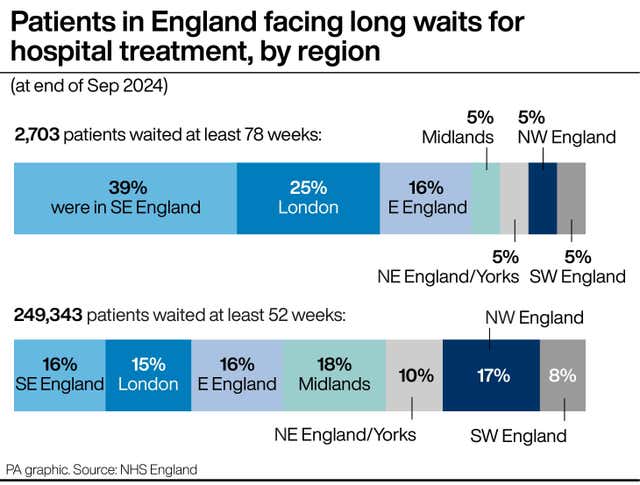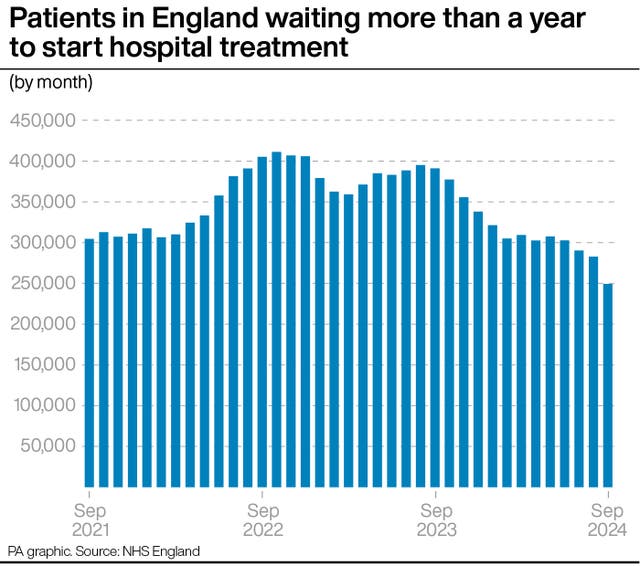Nine hospital trusts responsible for half of patients waiting the longest
Some 2,703 patients in England have been waiting at least a year and a half to begin NHS hospital treatment.

More than half of people waiting the longest for pre-planned hospital treatment in England are under the care of just nine hospital trusts, according to figures.
As of the end of September, 2,703 patients in England had been waiting at least a year and a half to begin NHS hospital treatment.
New analysis by the PA news agency shows that just nine NHS trusts together account for more than half (51.1%) of this total.
Hospitals were keen to stress that the number is coming down weekly and has reduced since the end of September.
And commentators said hospitals could be “struggling to make inroads” on the longest waits due to problems with getting people out of hospital who are medically fit but are awaiting social care.
They may also be facing high demand for emergency care services.
The analysis comes after Health and Social Care Secretary Wes Streeting said failing hospitals will be named and shamed in league tables and NHS managers sacked if they cannot improve patient care and take control of finances.
But experts said trusts should not be named and shamed but instead supported to boost services.
Indeed one hospital leader suggested the move would resurrect the so-called “targets and terror” era introduced under the Blair government.

The nine NHS trusts with the largest number of people waiting for at least a year and a half for pre-planned care, as of the end of September (the latest figures available), are:
– University Hospitals Sussex NHS Foundation Trust – 579 patients, or 21.4% of the total
– Norfolk & Norwich University Hospitals NHS Foundation Trust – 168 patients, 6.2% of the total
– Portsmouth Hospitals University NHS Trust – 162 patients, 6.0% of the total
– Milton Keynes University Hospital – 113 patients, 4.2% of the total
– Royal Free NHS Foundation Trust – 73 patients, 2.7% of the total
– Barts Health NHS Trust – 72 patients, 2.7% of the total
– Guy’s & St Thomas’ – 70 patients, 2.6% of the total
– King’s College Hospital – 65 patients, 2.4% of the total
– Lewisham & Greenwich NHS Trust – 57 patients, 2.1% of the total
All nine of these trusts are in southern or eastern England.

There were 249,343 patients in England at the end of September waiting at least a year to start treatment.
Some 28 NHS trusts together account for more than half (50.9%) of this total.
University Hospitals Sussex again accounts for the largest proportion, at 4.4% or 10,976 patients.
“As this analysis makes clear, there are some trusts who are struggling to make inroads in their longest waits. This can be down to a variety of reasons, including high bed occupancy due to high demand for urgent and emergency care, or a lack of community or social care to help discharge patients more quickly.
“It is vital that these trusts are supported to boost capacity and not just named and shamed when there are often long-standing factors that need to be addressed.
“One of the most important ways to do this is for the Government to continue to boost capital investment into the NHS so hospitals can repair dilapidated estates, replace out-of-date equipment and invest in the latest technologies.”

“But health leaders are ready to work with the Government on the elective recovery plan and 10-year health plan so they can tackle head-on the challenges facing the NHS.”
A spokesman for University Hospitals Sussex said: “As one of the largest trusts in the country, operating seven hospitals across Sussex, we recognise the magnitude of our waiting list challenges and know too many people are waiting too long for their care. However, we have responded with significant measures to improve this.
“The ongoing focus of our staff, and our system partners, is clear, and we will keep working at this pace to help make sure people receive safe, high-quality care as soon as is possible.”
Chris Cobb, chief operating officer at Norfolk and Norwich University Hospitals, said: “It is a priority of ours to accelerate our elective recovery to ensure patients can access care when they need it, which includes a programme of work to increase elective and day case activity and to also increase the number of new out-patient appointments as well as the proportion of patient-initiated follow-ups.
“Our teams are working hard to reduce waits by carrying out additional theatre lists and clinics at weekends. Where capacity is available at other trusts, some patients are also being offered treatment at other hospitals to help reduce waiting times.”
A spokesman for Portsmouth Hospitals University NHS Trust said: “Led by our clinicians, we have developed a plan to reduce long waiting times for planned care, with the aim of treating all patients waiting over 78 weeks by February 2025.
“This includes increasing theatre capacity by extending operating hours and adding weekend sessions, exploring support from our partners at NHS Hampshire and Isle of Wight and bringing in additional providers for some specialities.”
A Department of Health and Social Care spokesperson said: “Patients have been let down for too long whilst they wait for the care they need. We will tackle this head-on by delivering an extra 40,000 additional appointments per week.
“We are also sending teams of top clinicians to hospitals around the country to help cut waiting lists and we recently announced a package of reforms to attract top talent and crack down on failing services.
“September saw the size of the waiting list decrease and boosted by the extra investment secured at the Budget, we will cut waiting lists further, get patients seen faster and build an NHS fit for the future.”





